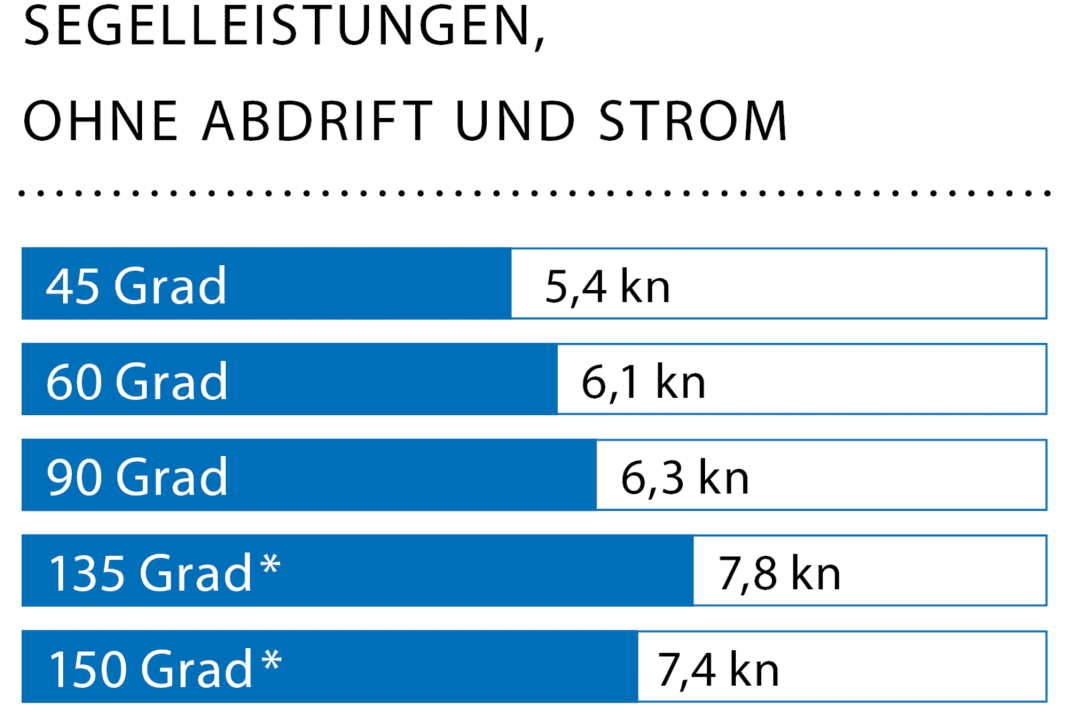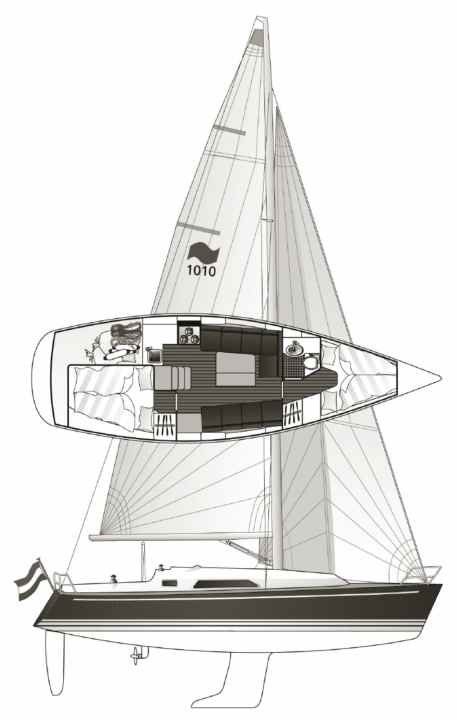Winner 10.10: A sought-after second-hand boat suitable as an agile family runabout






A used boat test takes a lot of coordination. The owner and his boat have to be ready. A photographer who can also film must be available, a camera boat must be available and, last but not least, the editor should also be on site. All the more annoying when the weather doesn't play ball.
Just like when we tested the Winner 10.10. The sun was shining, but unfortunately the IJsselmeer off Makkum mainly offered the notorious IJsselmeer tide, but only moderate wind. Four knots? That's not enough, you might think. But not for the Winner. With a little leeward trim and maximum profile in the cloths, she actually sets off. 2.8 knots at first, then over three as the apparent wind increases. You can even feel some pressure in the boat. That's something to be proud of.
Used boat profile
- Type: Winner 10.10
- Design engineer: Van de Stadt
- Built: 2005-2015
- Quantity: 50 + 10
- New price: 129,990 € (incl. 16 % VAT)
- Used price current: approx. 75,000 euros
The Winner is fun to sail even in light winds
Owner Klaas Johannink is satisfied: "That's exactly why I chose the Winner: I wanted a boat that could also sail in light winds. It's family-friendly. Because there is a limit at the top because of the waves. Above 18 knots, it's actually too uncomfortable for the family. And if the boat only sets off at 12 knots, then the sailable range is simply too small," explains the experienced sailor.
However, the Dutchwoman proved that the Winner also works in winds of more than four knots during the YACHT performance cruiser comparison test in 2008. She was the only one of the test participants who was able to hold her own against the X-34 at a good 4 Beaufort on the cross. Not a bad reference. The testers at the time recognised the high rigidity of the Van de Stadt design, which meant that she sailed more upright than her competitors. The result: height and speed downwind were just right.
Downwind, however, the competitors left the Winner standing, too narrow, too little waterline length. This means less theoretical hull speed. The shortened waterline length is a result of the positive stem, a characteristic of Van de Stadt and a handsome and classic one at that.
Playing with the trims should be mastered on the Winner 10.10
During the test, the wind has mercy and eventually reaches eight to ten knots. Enough to chase away the flies and get the Winner going even more. The wind edge is easy to find with the help of the lines in the jib and a little familiarisation with the tiller - there is no wheel. However, the Winner is not particularly communicative; if you want to steer, you should have done so before and have to concentrate on your own actions to some extent, at least at the beginning. She is therefore not a real beginner's boat. Although no questions arise when operating the sail plan, the helmsman must know what to do if he really wants to make fast progress. You also need to know how to play with the trim tabs.
Owner Johannink bounces around the boat all the time during the trip, looking here and pulling there. This is necessary to get the last ten per cent of sailing performance. If the trim is not optimal, the Winner still sets off well. However, as she is not necessarily a cheap boat even when used, the owner should at least occasionally develop a little ambition to utilise the potential that he has ultimately paid for.
Ergonomics with a question mark
The seating position is typically difficult on a tiller. Although there is a lot of space in the cockpit, the view forwards is restricted. Sitting on the coaming is a bit cramped, as the inclination there is too great. You are somehow strangely squashed and too close to the railing wire. On the other hand, the helmsman has everything under control there: the tiller on the boom, the traveller and even the foresheet when it is led around the leeward winch to windward. The helmsman also has full control of the mainsheet and fine adjustment. This allows gusts to be parried very sensitively. The powerful tackle in the backstay helps when the sheets are no longer sufficient. In short: the layout and equipment are made for fast sailing.
A galvanised steel frame, which is laminated into the hull over a large area, ensures that the hull handles the forces from the rig sensibly, i.e. without torsion, and converts them into propulsion instead of deformation. As steel is good at absorbing large forces without requiring a lot of height, the bilge is only six centimetres deep. On the one hand, this is good because it means a lot of headroom inside, 1.90 metres aft in the saloon. On the other hand, this means that nothing can accumulate in the bilge and any water that gets in is easily distributed throughout the boat.
What to look out for?
The steel frame therefore has advantages and disadvantages. However, one thing is clear: it must be very well protected. If it starts to rust, good advice is very expensive. When buying, it is therefore essential to check the area around the projections in the bilge. Hairline cracks? Traces of rust? Then it's better to wait for the next Winner 10.10 on the market or consult an experienced expert.
Another point to check is the small bulkhead under the foredeck. Any leaks in the anchor locker can allow water to penetrate in front of the bulkhead. This space is actually sealed off. If discolouration appears on the bulkhead, an inspection cover must be fitted. This allows the moisture to dry out. Of course, first find the leak in the anchor locker and seal it.
The Winner is built from laminate with foam sandwich, above the waterline. This makes the ship light and ensures good insulation. In areas where fittings are mounted, the shipyard has used aluminium plates instead of foam. They provide extra strength. A good thing in itself, but stainless steel screws in aluminium always mean trouble when you have to unscrew them. You often need special tools for this. If necessary, drill out the screw, saw it off and move the fitting. The plates are large enough for this.
A few models have been fitted with TBS decking instead of the anti-slip structure at the owner's request. After laminating, the waffle structure was sanded away and the light grey material was glued on. Of course, it has better anti-slip properties, but it can come loose. Replacing it is labour-intensive and therefore expensive. The original waffle structure is certainly easier to maintain.
Apart from that, there are no other particular points to be aware of with the Winner 10.10. The engines have always been from Yanmar and have a dual-circuit cooling system - which, with regular maintenance, speaks in favour of a long service life.
Pleasant living
Modern cosiness awaits below deck: light-coloured wood, good workmanship and suitable ergonomics. The berth dimensions are very large, the berths are over two metres long and 1.60 metres wide. The inner bed aft alone extends under the cockpit. This means it is only 40 centimetres high. Owner Johannink says he likes to hide away in this corner. The aft cabin, which is open to the saloon, ensures that there is no claustrophobia. A door was only offered after the facelift to the 10.20. However, since the foredeck and the toilet room there can be separated, the aft door is actually unnecessary.
The saloon is large and cosy, the table is huge. The galley works well. A nice detail and typical Winner: an opening leads into a rubbish bin that is located in the baking box. This keeps odours out of the saloon. The wet room is small but adequate, a shower is provided but is not standard.
High demand
The Winner is a sporty family boat. It enables fast and pleasant passages, which increases the range of action on holiday. The build quality is high and the details are pleasing. The comfort on board is good, also because of the really large berths. All in all, this makes it a sought-after boat when used. Examples on the market are often sold within a few weeks. You should therefore not hesitate to buy technically flawless models.
Alternatives are the X-34, which is more expensive on average, or the Dufour 34 Performance. The First 36.7 or even a slightly older 40.7 are also available for the price of a Winner 10.10, albeit with more living space, but also in poorer condition. If you want a Winner, you should definitely look in the Netherlands, where it is very popular. And rightly so.
Measured values of the Winner 10.10




The Winner 10.10 in detail

Technical data of the Winner 10.10
- Design engineer: Van de Stadt
- CE design category: A
- Torso length: 10,14 m
- Width: 3,25 m
- Draught/alternative: 1,80/1,40 m
- Weight: 4,3 t
- Ballast/proportion: 1,6 t/37 %
- Mainsail: 32,00 m2
- Furling genoa (100 %): 22,00 m2
- machine (Yanmar): 16 kW/21 hp
Hull and deck construction
GRP foam sandwich in hand lay-up process, full laminate under the waterline, steel frame laminated in
Price and shipyard
- Base price ex shipyard (2008): 129.990 €
- Built: 2005-2011/2015
- Used prices: approx.75.000 €
- Quantity 10.10/10.20: 50/10
Status 03/2024
Shipyard
Following insolvency in 2016, the German dealer Nordic Yachting took over the brand rights
YACHT rating
Sporty? Absolutely. And very stiff at the same time. And thanks to the large cockpit, it is also family-friendly under sail. Cosy and comfortable below deck with large berths. Timeless look, good build quality
Design and concept
- + Large aft enclosed cockpit
- + Steel-reinforced strongback
- - Open aft cabin
Sailing performance and trim
- + Incredibly handy
- + Very fast with little wind
Living and finishing quality
- + Very large bunks
- - Aft cabin interior low
- - Very shallow bilge
Equipment and technology
- + Fine adjustment mainsheet series
- + Waste bin in baking box
- +/- Tiller control
Model history and market
The market is overheated. Depending on the year of construction and condition, the 10.10 costs between 68,000 and 90,000 euros. It was built 50 times, a few of which were fitted with a TBS deck covering. From 2011, the 10.20 had external shrouds and therefore a 70 centimetre higher mast and a door in front of the aft chamber. The ship was built ten times. Ships on offer are usually sold quickly.
The Winner 10.10 in the video
The article first appeared in YACHT 21/2021 and has been updated for the online version.
More used boat tests:
- Grinde used boat test: Modern GRP classic is made for strong winds
- Hornet 32: High-quality cruising boat from the Elbe in a used boat test
- Biga 24: Beautiful, fast and complete even as a used boat
- Hallberg-Rassy 342: Popular used boat offers the usual quality
- Mitget 26: Solid from the Netherlands in a used boat test

